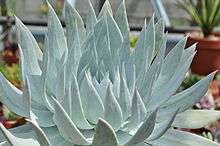Dudleya brittonii
Dudleya brittonii, with the common names Britton's dudleya and giant chalk dudleya, is a succulent plant in the family Crassulaceae. It is native to Baja California, Mexico.
| Dudleya brittonii | |
|---|---|
 | |
| Dudleya brittonii at the Wave Hill public garden, Bronx, New York | |
| Scientific classification | |
| Kingdom: | Plantae |
| Clade: | Tracheophytes |
| Clade: | Angiosperms |
| Clade: | Eudicots |
| Order: | Saxifragales |
| Family: | Crassulaceae |
| Genus: | Dudleya |
| Species: | D. brittonii |
| Binomial name | |
| Dudleya brittonii D.A.Johans. | |
Description
The leaves of Dudleya brittonii grow in a basal rosette and are covered with a dusty, chalky, mealy white epicuticular wax. The wax in its mealy state on the leaves is attracted to water and coats drops on the leaves and prevents their evaporation. The wax has the highest measured ultraviolet reflectivity of any plant.[1]
Dudleya brittonii is similar in appearance to Dudleya pulverulenta, native to California.
Cultivation
Dudleya brittonii is cultivated as an ornamental plant for use in well-drained rock gardens and as a potted succulent.[2]
It has gained the Royal Horticultural Society's Award of Garden Merit.[3]
References
- Spectral Properties of Heavily Glaucous and Non-Glaucous Leaves of a Succulent Rosette-Plant, Thomas W. Mulroy, Oecologia, 1979,
- San Marcos Growers
- "Dudleya brittonii". www.rhs.org. Royal Horticultural Society. Retrieved 3 June 2020.